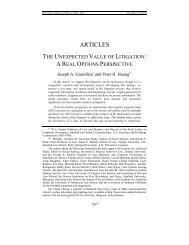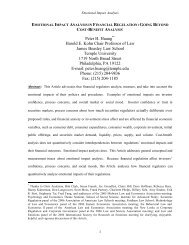Secure Implementation Experiments: Do Strategy-proof Mechanisms ...
Secure Implementation Experiments: Do Strategy-proof Mechanisms ...
Secure Implementation Experiments: Do Strategy-proof Mechanisms ...
Create successful ePaper yourself
Turn your PDF publications into a flip-book with our unique Google optimized e-Paper software.
for the profile v= ( v1, v2 )<br />
f<br />
f<br />
f<br />
is denoted by f( v) = ( y ( v), t ( v))<br />
, where y ( v ) is the level of the<br />
f f f<br />
public good and t ( v) = ( t 1<br />
( v), t 2<br />
( v))<br />
is the transfer vector.<br />
Definition 3. The SCF f is strategy-<strong>proof</strong> if<br />
f f f f<br />
1 1 2 1 1 2 1 1 2 1 1 2<br />
v ( y ( v , ~ v )) + t ( v , ~ v ) ≥ v ( y ( ~ v , ~ v )) + t ( ~ v , ~ v ) for all ~ v ∈V<br />
and ~ v ∈ V ; and<br />
f f f f<br />
2 1 2 2 1 2 2 1 2 2 1 2<br />
1 1<br />
2 2<br />
v ( y ( v , v )) + t ( v , v ) ≥ v ( y ( v , v )) + t ( v , v ) for all ~ v ∈V<br />
and ~ v ∈ V .<br />
1 1<br />
2 2<br />
By the Revelation Principle (Gibbard, 1973), strategy-<strong>proof</strong>ness is necessary for dominant<br />
strategy implementation, and therefore also for secure implementation. However, the following<br />
additional condition, called the rectangular property, is necessary for secure implementation.<br />
Definition 4. The SCF f satisfies the rectangular property if for all vv , ~ ∈ V, if<br />
f f f f<br />
1 1 2 1 1 2 1 1 2 1 1 2<br />
v ( y ( v , ~ v )) + t ( v , ~ v ) = v ( y ( ~ v , ~ v )) + t ( ~ v , ~ v ) and<br />
f f f f<br />
2 1 2 1 1 2 2 1 2 2 1 2<br />
v ( y ( ~ v , v )) + t ( ~ v , v ) = v ( y ( ~ v , ~ v )) + t ( ~ v , ~ v ) ,<br />
then f ( v1, v2 ) = f(~ v , ~ v )<br />
1 2 .<br />
Saijo et al. (2003) show that the rectangular property is necessary and sufficient for sure<br />
implementation: 7<br />
7 To see why the rectangular property is necessary for secure implementation intuitively, suppose that the direct<br />
revelation mechanism g = f securely implements the SCF f. Let n = 2 and ( v1, v2 ) be the true preference profile.<br />
Suppose u1( f( v1, ~ v2)) = u1( f( ~ v1, ~ v2)) , i.e.,<br />
f f f f<br />
(*) v1( y ( v1, ~ v2)) + t1 ( v1, ~ v2) = v1( y ( ~ v1, ~ v2)) + t1 ( ~ v1, ~ v2)<br />
.<br />
In other words, agent 1 is indifferent between reporting the true preference v 1 and reporting another preference ~ v 1<br />
when agent 2’s report is ~ v 2 . Since reporting v 1 is a dominant strategy by strategy-<strong>proof</strong>ness, it follows from (*) that<br />
f f f f<br />
v1( y ( ~ v1, ~ v2)) t1 ( ~ v1, ~ v2) v1( y ( v1, ~ v2)) t1 ( v1, ~ f<br />
f<br />
+ = + v2)<br />
≥ v1( y ( v1′ , ~ v2)) + t1 ( v1′<br />
, ~ v2) for all v1′ ∈V1,<br />
that is, reporting ~ v 1 is one of agent 1’s best responses when agent 2 reports ~ v 2 .<br />
Next suppose that u2( f( ~ v1, v2)) = u2( f( ~ v1, ~ v2))<br />
, i.e.,<br />
f f f f<br />
(**) v2( y ( ~ v1, v2)) + t1 ( ~ v1, v2) = v2( y ( ~ v1, ~ v2)) + t2 ( ~ v1, ~ v2)<br />
.<br />
f f f f<br />
By using an argument similar to the above, it is easy to see that v2( y ( ~ v1, ~ v2)) + t2 ( ~ v1, ~ v2) = v2( y ( ~ v1, v2)) + t2 ( ~ v1, v2)<br />
f<br />
f<br />
≥ v2( y ( ~ v1, v2′ )) + t1 ( ~ v1, v2′<br />
) for all v2′ ∈V2 ,<br />
14
















